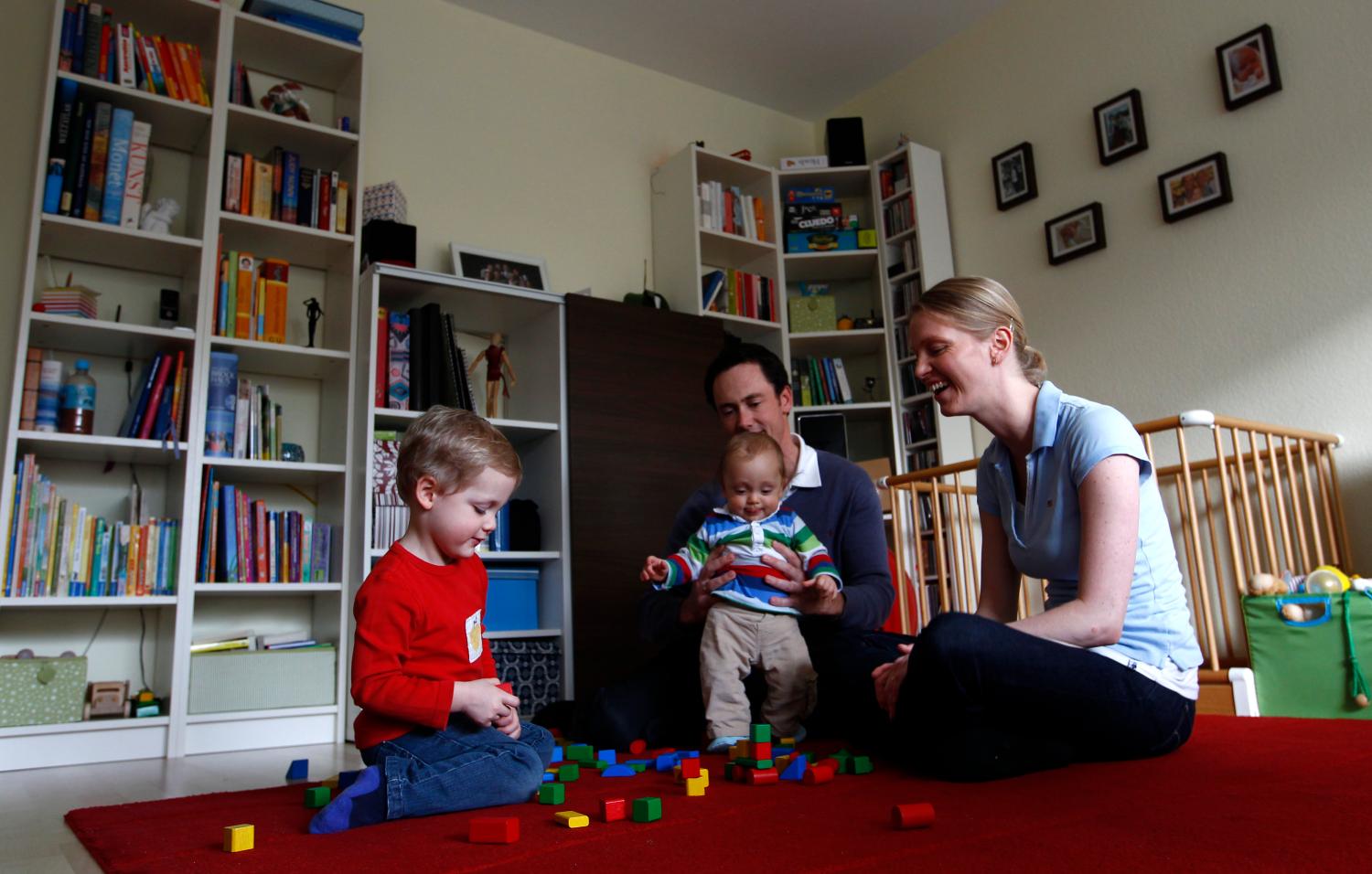Poor Work and Marry Less than the Nonpoor
Most people are poor in the United States because they either do not work or work too few hours to move themselves and their children out of poverty. More specifically, the heads of poor families with children worked only one half as many hours, on average, as the heads of nonpoor families with children in 2001, according to the Census Bureau (table 1). There are many reasons the poor work fewer hours than the nonpoor, including difficulty in finding jobs, the demands of caring for young children, poor health, transportation problems, substance abuse, and other personal problems. Although a shortage of job opportunities is often cited as an important reason for the poor’s lack of involvement in the work force, the gap in the work hours of poor and nonpoor families with children is observed in good years as well as bad. The state of the economy and the availability of jobs surely play some role, but are not the primary reasons for these differences in work effort. In short, the poor have less income in large measure because they work far fewer hours than their more affluent counterparts.
Another striking difference between the poor and nonpoor is the much smaller proportion of the poor who are married. In 2001, 81 percent of nonpoor families with children were headed by married couples. This compares to only 40 percent among poor families with children (table 1). In part this reflects higher marriage rates among the better educated or more skilled and in part it reflects the fact that such families increasingly have two earners, lifting them out of poverty whatever the size of their individual paychecks.
Still a third difference between the poor and the nonpoor is in levels of education. The average head of a poor family with children is a high school dropout, while the average head of a nonpoor family has completed some college (table 1). While lack of education is commonly cited as a prime source of poverty, it as we will see is less important than work and marriage in depressing family incomes.
Finally, poor families have more children than the nonpoor, requiring that their limited incomes support more people. Among families with children, the typical poor family has slightly more than two children whereas the typical nonpoor family has less than two (table 1). While this difference is small, it not only requires that available income be stretched a little further, but more importantly could inhibit work and marriage among single parents.
Reducing Poverty by Changing Behavior
The poverty rate for families with children was 13 percent in 2001. Using Census data and some simple modeling, we can simulate what would happen to the poverty rate under different assumptions about work, marriage, education, and family size among the poor. One can think of these as a series of tests to see which changes in behavior have the biggest effects in reducing the incidence of poverty.
The first simulation assumes that all non-elderly and non-disabled family heads work at least full-time. They receive the same hourly wage they currently earn-or could earn based on their education and other characteristics. This test shows that full-time work would reduce the poverty rate more than 5 percentage points from 13 to 7.5 percent (figure 1). Thus, full-time work eliminates almost half of the poverty experienced by families with children. (If work-related expenses were subtracted from income, the effects would be somewhat less dramatic. For more details, see A Hand Up for the Bottom Third: Toward a New Agenda for Low-Income Working Families, by Isabel Sawhill and Adam Thomas, Brookings, 2001).
A second simulation assumes that the same proportion of children live in female-headed families in 2001 as in 1970—before divorce and out-of-wedlock childbearing dramatically increased the proportion of children living with a single parent. The idea behind this test is to ask what would happen if as many people married and stayed married now as then. The test simulates marriages between single mothers and unmarried men who are similar in age, education, and race. These virtual marriages take place between real people who report their status to the Census Bureau. Thus, if there is a shortage of men, or if they have limited or no earnings, these conditions are reflected in the results. Once married, we combine the incomes of the two households. (The details of this simulation are described in “For Richer or for Poorer: Marriage as an Antipoverty Strategy,” by Adam Thomas and Isabel Sawhill, in the September 2002 issue of the Journal of Policy Analysis and Management).
The marriage simulation reduces the poverty rate among families with children by 3.5 percentage points, from 13 to 9.5 percent (figure 1). With a few exceptions, we find no shortage of unmarried men for these women to marry. The major exception is within the African-American population where there is a shortage of potential mates in some age and education categories. This shortage may be the result of the large number of young minority men who are incarcerated or dead or it may reflect the difficulty the Census Bureau has in finding and interviewing minority men in lower-income communities.
The third simulation assumes that every family head has at least a high school education and earns at least as much as high school graduates normally receive. Although not as big a poverty-reducer as full-time work or marriage, this test lowers the poverty rate among families with children by nearly two percentage points, from 13 to 11.1 (figure 1).
The fourth test estimates how much less poverty there would be if families had no more than two children. With the same income but fewer mouths to feed, they are better off. This simulation reduces the poverty rate among families with children by only 1.7 percentage points, from 13 to 11.3 percent, not as much as the other three simulations (figure 1).
Finally, we conduct a combined simulation implementing each of the four individual tests sequentially. The full-time work test is conducted first, then the high school education test, followed by the marriage test, and finally the test that assumes families have no more than two children. After each test, each family’s poverty status is reevaluated and only those families that are still poor are eligible to participate in the next test. The combined effect of these four tests is a 9.3 percentage-point drop in the poverty rate among families with children, from 13 percent to 3.7 percent. Thus, the poverty rate among families with children could be lowered by 71 percent if the poor completed high school, worked full-time, married, and had no more than two children.
What about Welfare?
For many years, liberals have advocated increasing welfare benefits as the best way to reduce poverty, especially among single parents. Many liberals remain concerned that the welfare law of 1996, by requiring work and encouraging marriage while time-limiting benefits, would have adverse consequences for the poor.
But just how helpful are welfare benefits compared to work and marriage in lifting people out of poverty? To answer this question, we conducted a simulation to determine the effect on poverty of doubling the amount of welfare benefits received by potentially eligible families. Because welfare benefits are underreported to the Census Bureau, we first corrected for this underreporting, and then simply doubled the (corrected) amounts received by each family. The result is revealing. Even a doubling of current benefit levels does less to reduce poverty than any of the simulations of behavioral changes reported above. We have to triple welfare benefits before they reduce poverty as much as any of the behavioral changes. Work, marriage, education, and family size are all more powerful determinants of the incidence of poverty than the amount of cash assistance received from the government. This conclusion is reinforced to the extent one believes that increasing cash benefits would undermine incentives to work, marry, complete one’s education, and limit the size of one’s family. None of these indirect effects of increased welfare is incorporated in these estimates.
Perhaps making all benefits—not just welfare—conditional on work could further reduce poverty. Research has shown that such conditionality increases employment. For example, since the mid-1980s, employment rates among single mothers have risen dramatically in part because of the increasingly generous wage supplements provided by the Earned Income Tax Credit (EITC), the increasing availability of child care subsidies, and the very substantial increases in health care coverage for families leaving welfare.
The Special Case of Single-Parent Families
Poverty is concentrated among single-parent families. For families with children, 32 percent are poor if the family is headed by a single parent but only 7 percent are poor if the family is headed by two married parents. Full-time work would more than halve the very high poverty rate among single-parent families. However, advocating work, and especially full-time work, among single parents is controversial. Indeed, current proposals from the Bush administration and House Republicans to require forty hours of work or other work-related activities each week from welfare mothers have been sharply criticized, not least by Republicans in the Senate.
This criticism may be justified if the focus is today’s single mothers and their children. Juggling work and family responsibilities is hard for any family and especially for those with limited income and education. And it is doubly difficult if child care is not available or affordable. At the same time, there is good evidence that the children in these families are likely to do better if placed in high-quality child care or early education than if left at home until the time they enter school. Thus, the opportunity exists to reduce both current poverty rates and improve children’s development by a two-generation policy of requiring work and placing children in high-quality care.
A Vision for the Future
Looking beyond the circumstances of today’s single mothers and focusing instead on a vision for the future leads us to suggest a comprehensive, behavior-based strategy for reducing poverty. The strategy is based on a set of normative expectations for the youngest generation. They would be expected to stay in school at least through high school, delay childbearing until marriage, work full-time to support any children they chose to bear outside marriage, and limit the size of their families to what they could afford to support. Existing policies would be aligned with this set of expectations. Income assistance would be conditional on work with some exceptions for hardship cases, including serious disability. Benefit programs (including tax credits and exemptions) would be capped at two children per family. This policy would not deny people the right to have more children, but it would require that they do so at their own expense. Marriage and work disincentives in existing benefit programs would be reduced wherever possible, not just by extending benefits up the income scale but also by making marriage and work a condition for receiving more types of assistance.
At the same time, some other benefits would be made more generous. Sawhill would guarantee good-quality child care to all low-income parents and add up to six months of paid leave for parents with infants or young children. Such leave would be conditional on having a substantial work history, would be available to all families, and would be subsidized on a sliding scale basis. Haskins does not support increases in family leave, but supports increased spending on child care, especially for poor children.
Paid leave would be combined with a more generous set of supports for low-income working families (including not only child care but also health insurance and the EITC). Unemployment insurance and community service jobs would be available for those unable to find work in the private sector, but only for a limited time, and only at minimum wage. Welfare as we know it would wither away. It would not be needed. After some future date it would simply not be available. The savings from eliminating welfare would be reinvested in some or all of the above programs. An initial demonstration of this system in one state, under waivers from the federal government, could be used to test this new approach and would help to establish its feasibility, net costs, and antipoverty effectiveness. In fact, the system that has been operating in Wisconsin for many years is already close to the model program we have in mind. However, many of its effects would not be clear until it had been in operation long enough, and on a large enough scale, to affect the attitudes and behaviors of the youngest generation.
Would It Work?
Public opinion polls suggest that such a system would be far more popular than existing programs. Ending welfare resonated with the voters when Bill Clinton first proposed it in his 1992 presidential campaign and when sweeping reforms based on work and personal responsibility were enacted on a bipartisan basis in 1996. Polls have consistently shown that the public is much more willing to support those who work than those who don’t.
The data reviewed above suggest that work is a powerful antidote to poverty. Moreover, the expectation of work has implications for education, marriage, and family size. Young people who know that they are going to have to work would be more likely to finish school. Those who aspire to be stay-at-home mothers for an extended period would be more likely to delay having children until they are married since the government would no longer subsidize them to be full-time mothers. And those required to work would have less time to care for additional children and might plan their families accordingly. Indeed, serious work requirements may be more of an incentive to finish school, delay childbearing until marriage, and limit the size of one’s family than all the combined government programs directly aimed at these objectives.
In addition to the data and arguments about the strong antipoverty effectiveness of work reviewed above, a number of demonstration programs point in a similar direction. For example, the Canadian Self-Sufficiency Project (SSP) requires that in order to qualify for generous wage supplements, former welfare recipients must work at least thirty hours a week. Studies suggest that it has been one of the most cost-effective antipoverty policies ever implemented because every dollar of government assistance produces several additional dollars of earnings within the target population as a result of the strong work requirements embedded in the program. Thus, the program has dramatically increased employment and incomes among recipients, reduced welfare dependency and poverty, and done all of this while imposing modest additional costs on government.
Contrast this to the current system in the United States, where disincentives to work are large. As incomes rise, various forms of assistance are scaled back and payroll and other taxes begin to take a larger bite out of people’s earnings. For example, a couple each earning 1.5 times the minimum wage gets to keep less than 20 cents of each additional dollar they earn, according to a study from the National Center for Policy Analysis. If this couple moves from working part-time to full-time, they do not gain at all. Every dollar of additional earnings is offset by higher taxes and lower benefits. One way to reduce these disincentives is to make existing assistance conditional on work, including full-time work, and to eliminate anything other than temporary assistance for those who do not work at all.
Conclusion
Advocates for the poor have too long argued that welfare was the solution to poverty. Yet most evidence points in a different direction. The reform of welfare in 1996 has had far more positive effects on employment, earnings, and poverty rates than almost anyone anticipated. The data summarized in this brief suggest this is because work is a powerful antidote to poverty and that, in its absence, no politically feasible amount of welfare can fill the gap as effectively.
The short-term implication of this finding is that fiscally strapped states need help if they are to continue to fund programs that move welfare recipients into the work force and keep them there in a softer economy. The longer-term implication is that steps should be taken to move the entire system of benefits targeted to lower-income Americans more toward encouraging work and marriage and less toward providing unconditional assistance to those who do not work and who bear children outside of marriage. Because work-related benefits are more politically popular than those not tied to work, the system would not only be more effective per dollar spent, but it might well enjoy the political support that would make it more generous than the one it replaced.
The Brookings Institution is committed to quality, independence, and impact.
We are supported by a diverse array of funders. In line with our values and policies, each Brookings publication represents the sole views of its author(s).





